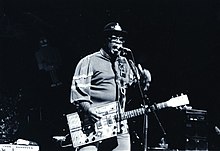
The Bo Diddley beat is a syncopated musical rhythm that is widely used in rock and roll and pop music.[1][2][3] The beat is named after rhythm and blues musician Bo Diddley, who introduced and popularized the beat with his self-titled debut single, "Bo Diddley", in 1955. The beat is essentially the Afro-Cuban clave rhythm[4] or based on the clave[5][6] or a variation thereof.[7][8]
Music educator and author Michael Campbell explains that it "shows the relationship between Afro-Cuban music, Americanized Latin rhythms, and rock rhythm ... [The beats] are more active and complicated than a simple rock rhythm, but less complex than a real Afro-Cuban rhythm.[8]
- ^ Brown, Jonathan (June 3, 2008). "Bo Diddley, Guitarist Who Inspired the Beatles and the Stones, Dies Aged 79". Independent.co.uk. Retrieved April 26, 2012.
- ^ "Bo Diddley". Rock and Roll Hall of Fame. Retrieved October 27, 2008.
- ^ "Bo Diddley". Rollingstone.com. 2001. Retrieved April 26, 2012.
- ^ Thomakos, John (2010). "Bo Diddley Beat". The Drum Set Styles Encyclopedia. Mel Bay Publications. p. 67. ISBN 978-1610652193.
The heart of this [Bo Diddley beat] trademark groove is essentially a 3-2 clave rhythm, played with a strong swing.
- ^ Martin, Andrew R.; Mihalka, Matthew (2020). Music Around the World: A Global Encyclopedia. Santa Barbara, California: ABC-CLIO. p. 179. ISBN 978-1610694995.
Bo Diddley's 1955 self-titled track featuring the 'Bo Diddley Beat' that was based on the clave rhythm.
- ^ Roscetti, Ed (2008). Stuff! Good Drummers Should Know: An A to Z Guide to Getting Better. Hal Leonard. p. 16.
the Bo Diddley beat, based on the rumba or clave rhythm
- ^ Horne, Greg (2000). Intermediate Acoustic Guitar. Alfred Publishing. p. 38. ISBN 0-7390-0426-3.
The Bo Diddley Beat – This is a variation of the clave made famous by Bo Diddley.
- ^ a b Campbell, Michael (2009). Popular Music in America: And the Beat Goes On (3rd ed.). Boston, Massachusetts: Cengage Learning. p. 167. ISBN 978-0-495-50530-3.